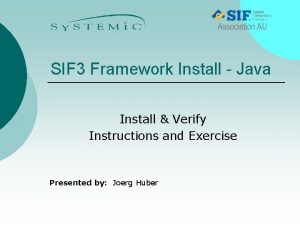Critical Sections and Race Conditions Administrivia Install and















![Example: Per-Thread Counts and Total /* shared by all threads */ int counters[N]; int Example: Per-Thread Counts and Total /* shared by all threads */ int counters[N]; int](https://slidetodoc.com/presentation_image/2380493e02c0abc7257f72c2320a2c46/image-16.jpg)
![Using a Lock for the Counter/Sum Example int counters[N]; int total; Lock *lock; /* Using a Lock for the Counter/Sum Example int counters[N]; int total; Lock *lock; /*](https://slidetodoc.com/presentation_image/2380493e02c0abc7257f72c2320a2c46/image-17.jpg)


- Slides: 19

Critical Sections and Race Conditions

Administrivia Install and build Nachos if you haven’t already. http: //www. cs. duke. edu/~anderson/110/building. html “I need more space to build Nachos. ” The ball is in ACPUB’s court. Until then, only build in the threads directory (needs 1. 2 MB). Lab #1 is due. . . Follow submission instructions in the project guide. E-mail your project group info before the deadline! Reading: Nutt: chapter 8 (Synchronization) Birrell, “An Introduction to Programming with Threads”

Warmup 1. What does it mean for threads to execute “concurrently”? How does this happen? 2. Why/when do context switches occur? 3. What happens on a context switch? 4. What causes programs to “crash”? 5. If a multithreaded program “crashes” and I show a stack trace in gdb, what will I see? 6. Can I use gdb to look at all the threads in my program? 7. What happens if I delete a thread while it’s running? 8. What happens if a thread makes recursive calls “forever”?

Race Conditions Defined 1. Every data structure defines invariant conditions. defines the space of possible legal states of the structure defines what it means for the structure to be “well-formed” 2. Operations depend on and preserve the invariants. The invariant must hold when the operation begins. The operation may temporarily violate the invariant. The operation restores the invariant before it completes. 3. Arbitrarily interleaved operations violate invariants. Rudely interrupted operations leave a mess behind for others. 4. Therefore we must constrain the set of possible schedules.

Resource Trajectory Graphs Resource trajectory graphs (RTG) depict the thread scheduler’s “random walk” through the space of possible system states. S Sn m So RTG for N threads is N-dimensional. Thread i advances along axis I. Each point represents one state in the set of all possible system states. cross-product of the possible states of all threads in the system (But not all states in the cross-product are legally reachable. )

Avoiding Races #1 1. Identify critical sections, code sequences that: • rely on an invariant condition being true; • temporarily violate the invariant; • transform the data structure from one legal state to another; • or make a sequence of actions that assume the data structure will not “change underneath them”. 2. Never sleep or yield in a critical section. Voluntarily relinquishing control may allow another thread to run and “trip over your mess” or modify the structure while the operation is in progress.

Critical Sections in the Color Stack Init. Color. Stack() { push(blue); push(purple); } Push. Color() { if (s[top] == purple) { ASSERT(s[top-1] == blue); push(blue); } else { ASSERT(s[top] == blue); ASSERT(s[top-1] == purple); push(purple); } }

OK, so we never Sleep or Yield in a critical section. Is that sufficient to prevent races?

Avoiding Races #2 Is caution with yield and sleep sufficient to prevent races? No! Concurrency races may also result from: • involuntary context switches (timeslicing) e. g. , caused by the Nachos thread scheduler with -rs flag • interrupts (inside the kernel) or signals (outside the kernel) • physical concurrency (on a multiprocessor) How to ensure atomicity of critical sections in these cases? Synchronization primitives!

Mutual Exclusion and Locks

Administrivia Lab #1 is due at midnight. Carefully follow submission instructions in the project guide. E-mail your project group info before midnight. You may continue to work on projects after the deadline for lessthan-full credit (tell us what you did). A new experiment: Web-based signup for demos. Look for it on the course Web page. At least one group member must have a password (see Rajiv). Reading: Nutt: chapter 8 (Synchronization) Birrell, “An Introduction to Programming with Threads”

Avoiding Races 1. Don’t yield or sleep in a critical section. Necessary but not sufficient. . . 2. Concurrency races may also result from: • involuntary context switches (timeslicing) e. g. , caused by the Nachos thread scheduler with -rs flag • interrupts (inside the kernel) or signals (outside the kernel) • physical concurrency (on a multiprocessor) How to ensure atomicity of critical sections in these cases? Synchronization primitives!

Mutual Exclusion Race conditions can be avoiding by ensuring mutual exclusion in critical sections. • Critical sections are code sequences that contribute to races. Every race (possible incorrect interleaving) involves two or more threads executing related critical sections concurrently. • To avoid races, we must serialize related critical sections. Never allow more than one thread in a critical section at a time. 1. BAD 2. interrupted critsec BAD 3. GOOD

Locks can be used to ensure mutual exclusion in conflicting critical sections. • A lock is an object, a data item in memory. Methods: Lock: : Acquire and Lock: : Release. A • Threads pair calls to Acquire and Release. • Acquire before entering a critical section. A R • Release after leaving a critical section. R • Between Acquire/Release, the lock is held. • Acquire does not return until any previous holder releases. • Waiting locks can spin (a spinlock) or block (a mutex).

Portrait of a Lock in Motion R A A R
![Example PerThread Counts and Total shared by all threads int countersN int Example: Per-Thread Counts and Total /* shared by all threads */ int counters[N]; int](https://slidetodoc.com/presentation_image/2380493e02c0abc7257f72c2320a2c46/image-16.jpg)
Example: Per-Thread Counts and Total /* shared by all threads */ int counters[N]; int total; /* * Increment a counter by a specified value, and keep a running sum. * This is called repeatedly by each of N threads. * tid is a thread identifier unique across all threads. * value is just some arbitrary number. */ void Touch. Count(int tid, int value) { counters[tid] += value; total += value; }
![Using a Lock for the CounterSum Example int countersN int total Lock lock Using a Lock for the Counter/Sum Example int counters[N]; int total; Lock *lock; /*](https://slidetodoc.com/presentation_image/2380493e02c0abc7257f72c2320a2c46/image-17.jpg)
Using a Lock for the Counter/Sum Example int counters[N]; int total; Lock *lock; /* * Increment a counter by a specified value, and keep a running sum. */ void Touch. Count(int tid, int value) { lock->Acquire(); counters[tid] += value; /* critical section code is atomic. . . */ total += value; /* …as long as the lock is held */ lock->Release(); }

Reading Between the Lines of C load add store vulnerable between load and store of counters[tid]. . . but it’s non-shared. vulnerable between load and store of total, which is shared. /* counters[tid] += value; total += value; */ load shl add load add store counters, R 1 8(SP), R 2, #2, R 2 R 1, R 2, R 1 4(SP), R 3 (R 1), R 2, R 3, R 2, (R 1) total, R 2, R 3, R 2, total ; load counters base ; load tid index ; index = index * sizeof(int) ; compute index to array ; load value ; load counters[tid] ; counters[tid] += value ; store back to counters[tid] ; load total ; total += value ; store total

The Need for an Atomic Primitive To implement safe mutual exclusion, we need support for some sort of “magic toehold” for synchronization. • The lock and mutex primitives themselves have critical sections to test and/or set the lock flags. • These primitives must somehow be made atomic. uninterruptible a sequence of instructions that execute “all or nothing”
 Critical semi critical and non critical instruments
Critical semi critical and non critical instruments Spaulding classification of medical devices ppt
Spaulding classification of medical devices ppt What is a turbine
What is a turbine Types of spillway
Types of spillway Data race vs race condition
Data race vs race condition Purdue owl literary theory
Purdue owl literary theory Tribal critical race theory
Tribal critical race theory Crt theory
Crt theory Hermeneutics theory
Hermeneutics theory Critical race theory
Critical race theory Critical reading meaning
Critical reading meaning Lab 3-5: install and configure dhcp and dns servers
Lab 3-5: install and configure dhcp and dns servers What are ways to install and maintain equipment
What are ways to install and maintain equipment Lab 3-9: testing mode: select and install memory
Lab 3-9: testing mode: select and install memory Install git jupyter notebook
Install git jupyter notebook B1if sap business one
B1if sap business one How to install silt fence correctly
How to install silt fence correctly Instalar moodle en windows
Instalar moodle en windows Maintop dtp settings
Maintop dtp settings Spectrum.net self install activation
Spectrum.net self install activation





































